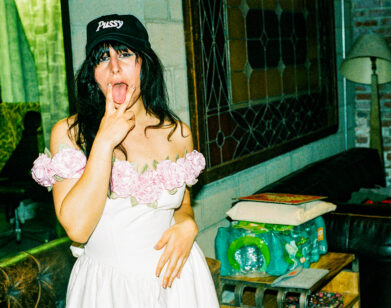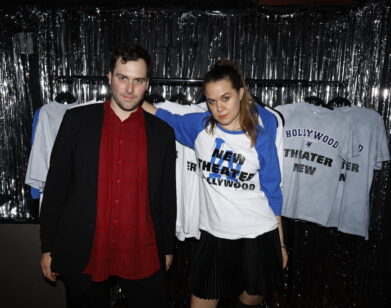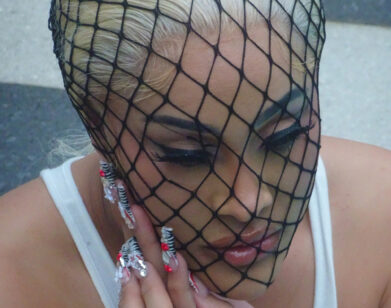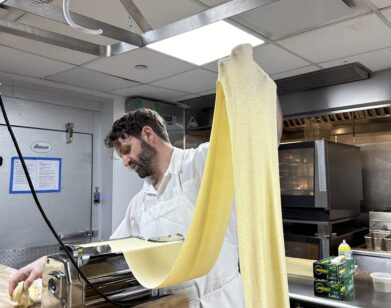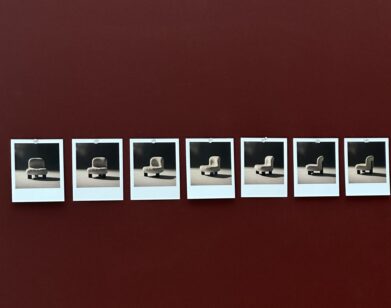Who the Hell is James Goldstein?
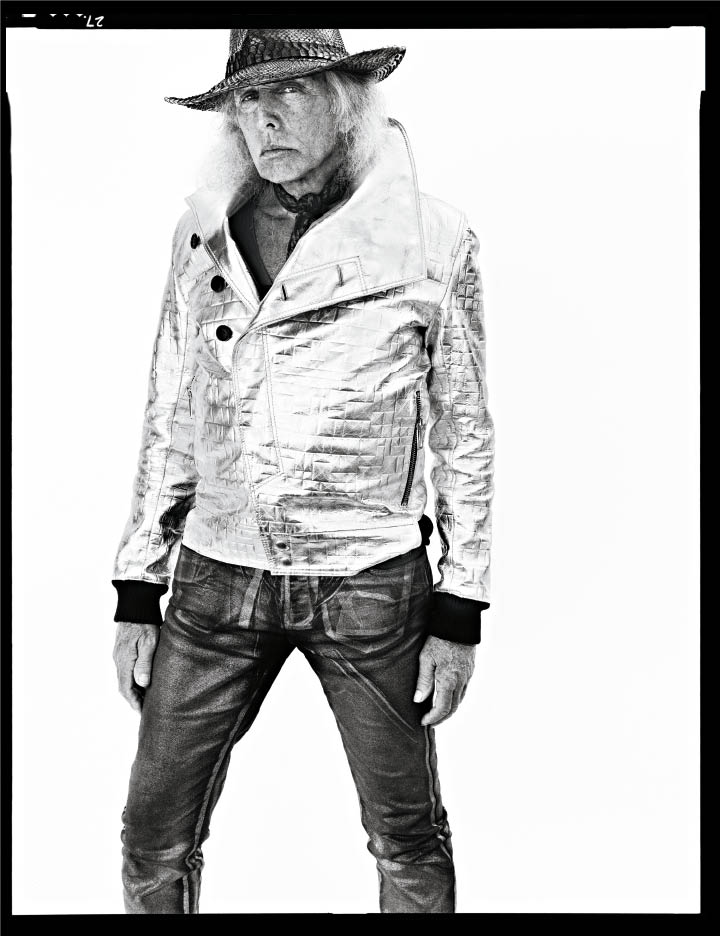

James Goldstein is easy to pick out of a crowd. He’s a slight, older gentleman whose daily uniform consists of a tight, tapered suit made of some sort of exotic skin—maybe it’s python, maybe it’s ostrich—and topped with an elaborate hat, which is also often made of an exotic skin. Goldstein’s life, though, has become a sort of legend, born of three seemingly disparate occupations spelled out cryptically on his business card: fashion, architecture, and basketball.
For the past several decades—we’re not sure exactly how many, and Goldstein isn’t saying—he has traveled from his home in Los Angeles to New York, London, Milan, and Paris to view the international fashion collections, and he has become a fixture at the events and parties that surround them. His home in L.A. is one of architect John Lautner’s legendary residential properties and has appeared in movies like The Big Lebowski (1998) and Charlie’s Angels: Full Throttle (2003). He has also been a Lakers season-ticket holder since the team moved to L.A. in the early ’60s, and spends the better portion of the basketball season traveling around the country to attend games in different cities. “James Goldstein is our largest investor in NBA tickets in the world,” says David Stern, commissioner of the NBA. “And, he’s the most uniquely dressed fan.” “He has a true love for fashion,” adds Jean Paul Gaultier, whose shows Goldstein has attended for years. “It’s reflected in the confident and unique way he dresses.”
As Goldstein’s lifestyle would attest, he is a man of considerable means, but he is cagey about how he made his money or what motivates him, which has spawned a variety of theories about him—that he once had an affair with a famous Hollywood pinup, that he made his money in the trailer-park business—with only disjointed bits of his biography confirmed, and his own admitted delight in the outrageous mystery of it all.
High in the hills of 90210 sits Goldstein’s humble abode. Originally built by Lautner in 1963, the house juts out in concrete triangles and clear glass rhombuses over a panoramic view of the city. Goldstein bought the place in 1972 and has been renovating, updating, and expanding it since 1980. It features all the accoutrements of a lifelong bachelor pad: TV screens come out of ceilings, portholes in the pool look into his bedroom, a JamesTurrell skyspace sits on the bottom of a hill, parts of the clear glass roof retract to reveal a private jungle planted around the manse, and photos of Goldstein posing with famous people line the walls of the interior. “There has been construction going on literally every day for the past 30 years,” Goldstein says. His latest megaproject is a new structure in his backyard that will eventually contain his office, a fully functional nightclub, an offshoot terrace, and guest rooms—all located beneath a tennis court.
I met Goldstein at his house on a sunny California day in November. When he called to give me directions, he told me the door would be open and I could find him out by the pool. Sure enough, after winding my way down his long, twisted driveway, I found him sitting in a folding chair bythe water, wearing a yellow John Galliano T-shirt and hot-pink Galliano running shorts that coordinated perfectly with his yellow, blue, and pink Niketennis shoes. He took me on a tour of the house, and then we returned poolside to chat.
DEREK BLASBERG: This is a weird interview for me. I typically speak to friends or people who I know really well. But I couldn’t find anyone who knew much about you, Jim.
JIM GOLDSTEIN: I can give you a list of people who could give you some perspective, if you want. Lots of people know about me.
BLASBERG: That’s true. But according to my research, not many people know your actual story.
GOLDSTEIN: I realize I’ve become somewhat of a legend, yes. And that has brought stories with it. . . . But I like that.
BLASBERG: So you’re aware of some of the good ones? Like, that you made a fortune selling trailer parks, or that you were a porn director in the ’70s? Which ones are true?
GOLDSTEIN: Well, I’ve never done porn or had porn shot at my house. I’ve never been involved in Hollywood or the entertainment world. The fashion world? Yes. But there is very little fashion in Hollywood.
Photo: James Goldstein in Los Angeles, November 2009. All clothing: Goldstein’s own. Jacket and pants: Gucci. T-shirt: John Galliano. Hat: Jean-Pierre Tritz. Scarf: Ashley Ashoff. Belt: Roberto Cavalli. Boots: Jean-Michel Gaznet.
My business cards say FASHION ARCHITECTURE BASKETBALL. When people ask me what I do, they’re usually trying to ask how I made my money, not what my job is. In my mind, what I do is those three things.James Goldstein
BLASBERG: So none of the stories are true?
GOLDSTEIN: Did you hear about a romance I had when I was very young with a very famous woman?
BLASBERG: Was it Jayne Mansfield? I saw her in one of the pictures on your wall. Is that the story?
GOLDSTEIN: That’s the truth! But the story is that I was involved with Marilyn Monroe. Or when I go to Saint-Tropez, I hear it go around that I used to be with Brigitte Bardot.
BLASBERG: I like that we’re setting the record straight here. What was Jayne Mansfield like?
GOLDSTEIN: She was very funny and very bright. But she had a little bit of a drinking problem, and she’d get pretty crazy at night. It was a very exciting experience for me, though—I was still in college, I had just moved to L.A., and I had never had any contact with Hollywood glamour. I met her at the Whisky a Go Go on Sunset, which had just opened. I asked her to dance, and she asked me to go home with her.
BLASBERG: How did the relationship go?
GOLDSTEIN: She was married at the time, and I had some harrowing experiences where my life was threatened and I was beaten up. But then she left the country on a long personal-appearance tour. And finally, when she came back to the U.S., things weren’t the same anymore.
BLASBERG: I gather you took a liking to that sort of glamour. You have framed pictures of yourself with famous people in every room of your house.
GOLDSTEIN: Because of my involvement in the fashion world and all the fashion shows I attend, I’ve definitely developed a preference for tall, slender models. You live in New York, where there are so many models, but I’ve found that the rest of the United States doesn’t have the same appreciation for the tall, slender figures I love. In Los Angeles, there’s a preponderance of women who are short and have breast implants.
BLASBERG: While we’re clearing things up and talking about L.A., let’s clarify exactly how you ended up here: Where did you grow up?
GOLDSTEIN: I grew up in Milwaukee. I came out to California at the age of 18 to go to college, and then I stayed here.
BLASBERG: What did you study in college?
GOLDSTEIN: I started at Stanford and was very good at mathematics. So I started out studying that and physics. But I decided that was really not what I wanted to do with my life, so I got into economics and finance and eventually ended up in the investment field here in California. That worked out very well for me—and it required very little of my time and allowed me to do the things that I really enjoy.
BLASBERG: So you’ve been out here since . . .
GOLDSTEIN: Since the age of 18.
BLASBERG: And you’ve been in this house since 1972.
GOLDSTEIN: Right. I was living in apartments in West Hollywood prior to that.
BLASBERG: Why did you buy this house?
GOLDSTEIN: The initial motivation for buying the house was that I had gotten an Afghan hound—Natasha, the love of my life—and those dogs love to run. She was cooped up in my high-rise apartment, so I decided I had to find a property with more room.
BLASBERG: What was it about this house?
GOLDSTEIN: I had grown up in Wisconsin and had been very much impacted by Frank Lloyd Wright, who was also from Wisconsin. My good friend in school lived in a Wright house a block from where I lived, and my father’s business was near the Johnson Wax plant, which was designed by Wright. Before I even closed the purchase, I contacted Lautner and found out more about him—like that he had been working for Frank Lloyd Wright and had the same mentality.
BLASBERG: What was your father’s business?
GOLDSTEIN: My father owned a small department store in Racine, Wisconsin. He got me going on clothes at a young age. But he was a very conservative dresser, so I quickly branched out from what he liked.
BLASBERG: Were you always a flamboyant dresser?
GOLDSTEIN: Yes. I can remember when I was about 13, pink became a fashionable color, and everyone was wearing pink shirts. I took it a step further and got a pink suit. I was always trying to be ahead of everyone else in fashion, and as a teenager I was very much into the way I dressed. In my early twenties, I went to Paris for the first time, and that really had a strong impact on my fashion awareness. I stepped it up considerably from that point on, and I still feel like I’m advancing more and more in my look.
BLASBERG: Where do you shop now?
GOLDSTEIN: I do most of my shopping in Paris and Milan. Everything I buy is from European designers.
BLASBERG: Who are some of your favorites? I see that you’re in Galliano today.
GOLDSTEIN: Yes. I love John Galliano. I buy Gucci, Dior, Roberto Cavalli. From time to time I buy Dolce & Gabbana.
BLASBERG: Have you met some of these designers?
GOLDSTEIN: I know all the designers I wear. For many years, I was wearing mostly Jean Paul Gaultier, and I’m friends with him. Before that, I was wearing Claude Montana extensively. When Roberto Cavalli first started designing men’s clothes—which was his peak, as far as I’m concerned—I was buying almost the entire Cavalli line every season. I was very well known for wearing Cavalli—to the extent that some of the other designers wouldn’t let me come to their shows.
BLASBERG: When did you start going to shows?
GOLDSTEIN: As far as I remember, I started going to the shows of the designers whose clothes I wore at least 20 years ago—particularly Jean Paul Gaultier.
BLASBERG: How would you get the invitations?
GOLDSTEIN: Originally, a friend of mine, Tommy Perse, who owns Maxfield here in L.A., started giving me invitations to the Gaultier shows. And then, as I got more interested in other shows, he would supply me with more invitations. And then, as I got recognized more and more often in Paris and Milan, I reached a point where I could just show up and they’d let me in.
BLASBERG: Have you ever thought about becoming more involved in fashion, beyond just crashing the shows?
GOLDSTEIN: In recent years, as I’ve become better known on the fashion circuit and have stepped up my appearances at fashion shows, I’ve become so recognizable that the fashion photographers now swarm around me when I go to these shows.
BLASBERG: But you like the attention.
GOLDSTEIN: I get a kick out of it. I’m not doing it for any monetary reason. I’m doing it for fun.
BLASBERG: Let’s talk more about this home you’ve built.
GOLDSTEIN: I didn’t know much about Lautner when I stumbled upon this house, but I knew I wanted it. Someone else had it under contract, and when he tried to renegotiate the purchase, I stepped in and bought it. When I was ready to start working on the house, I brought Lautner in to see it. He was shocked to see what had happened to it. One of the previous owners had just destroyed the place—he painted the concrete ceilings green and yellow. So we worked together for almost 15 years before he died, and I think he was really thrilled with the opportunities I gave him. As far as I know, it was the first time he was given the opportunity to design furniture and really work on the entire house, inside and out, and bring it up to its full potential.
BLASBERG: Was redoing the house an expensive undertaking?
GOLDSTEIN: I never gave Lautner any budgetary constraints. It was always a case of, What is the best possible way to do this?
BLASBERG: No budget at all?
GOLDSTEIN: Never. I still don’t have a budget on that nightclub addition. Whatever it takes.
Photo: Jacket: Dior Homme. T-shirt: John Galliano. Pants: Gucci. Hat: Jean-Pierre Tritz. Scarf: Ashley Ashoff. Stylist Assistant: Karen Kaiser. Production: NORTH6.
BLASBERG: So tell me, is this house your full-time occupation right now?
GOLDSTEIN: My business cards say FASHION ARCHITECTURE BASKETBALL. When people ask me what I do, they’re usually trying to ask how I made my money, not what my job is. In my mind, what I do is those three things. They occupy most of my time: fashion, going around to all the fashion weeks and being such a fanatic when I pick out my clothes, trying to be in the latest fashions. Architecture, which you can see here, with this house. And basketball, which is another full-time occupation for me.
BLASBERG: How much time could being a basketball fan take up?
GOLDSTEIN: I go to about four or five games a week during the regular season here in Los Angeles. And then when the playoffs start, I’m on the road getting on an airplane every day for about seven weeks.
BLASBERG: Were you always a Lakers fan?
GOLDSTEIN: No! I’m not a Lakers fan. I actually pull for the visiting teams. I consider myself an NBA fan because I follow every team equally. I just happen to live in L.A. I think that no matter where I lived, I would not be a fan of the home team. If everybody is favoring one team, I always go the other way.
BLASBERG: But you still go to every single game?
GOLDSTEIN: I don’t just go to the games in L.A. The playoffs are such an exciting time in my life. I’ve gotten recognition as being the number-one basketball fan. But I don’t do it for the fame—my basketball fame evolved by accident. I just went because I enjoyed it so much—the recognition has happened by itself. The same thing happened in fashion.
BLASBERG: How would you describe the way you look?
GOLDSTEIN: First, I’d say I don’t want to look like anyone else, but I want to do it in a tasteful, stylish way. I want to stay up with the latest possible styles, so that every season I do my utmost to find something that’s new, that’s never been done before, but that’s in tune with the latest style, whether fabrics or exotic skins. When it comes to my look, I want to be as trendy as possible, and at the same time, I want clothes that look good on me. I feel that I’ve been able to maintain my figure pretty well.
BLASBERG: Do you ever say how old you are?
GOLDSTEIN: In recent years, I haven’t disclosed my age.
BLASBERG: But I’ve seen you out on the town, and I don’t mean this in a disrespectful way, but you’re often the oldest person in the room. By far. Like, I saw you at my friend’s gallery opening last night, and my friend is 24.
GOLDSTEIN: It’s funny that we ran into each other at that party because almost everyone there was young. But I felt like I fit into that scene last night like a glove. I had a great time; everyone was coming over to me, right and left. I feel like that’s the crowd I belong with. If I were with people my age? Forget it. I still feel like I’m in my 20s. I still do everything I did then. I still have the same energy, which people can’t believe. I was traveling all summer and fall through Europe, and for four months I went out every single night to the clubs, and never got tired.
BLASBERG: Well, it’s true that probably only a young man would want a nightclub in his backyard.
GOLDSTEIN: Exactly.
BLASBERG: What are you going to stock the bar with?
GOLDSTEIN: Everything.
BLASBERG: What do you drink when you go out?
GOLDSTEIN: I don’t drink alcohol. I drink fresh juice. That’s my secret.
Learn more and James Goldstein at his Web site.
Derek Blasberg is a New York–based fashion journalist and writer. He is one of V Magazine’s senior editors and a contributing editor at style.com.

